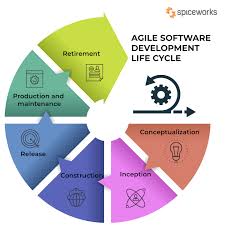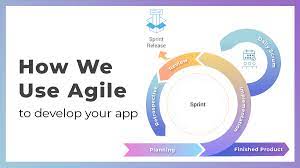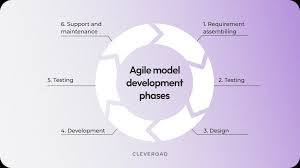The Agile and Innovative Software Development Model
In today’s fast-paced world, traditional software development models are often unable to keep up with the rapidly changing demands of the market. This is where the Agile software development model comes into play, offering a more flexible and adaptive approach to building software.
Agile software development focuses on breaking down the entire development process into smaller, manageable increments known as sprints. Each sprint typically lasts a few weeks and results in a working piece of software that can be reviewed and tested by stakeholders.
One of the key principles of Agile is its emphasis on collaboration and communication among team members. By fostering a culture of collaboration, Agile teams are able to quickly adapt to changing requirements and deliver high-quality software that meets customer needs.
Another important aspect of Agile is its focus on continuous improvement. Through regular feedback from stakeholders and team retrospectives, Agile teams are able to identify areas for improvement and make adjustments to their processes accordingly.
Overall, the Agile software development model offers a more iterative and customer-centric approach to building software. By embracing flexibility, collaboration, and continuous improvement, Agile teams are able to deliver innovative solutions that meet the ever-evolving needs of the market.
Understanding Agile and Innovative Software Development: Key FAQs
- What is Agile model in software development?
- What is the agile model of development?
- What is Agile innovation methodology?
- What are the 5 Agile models?
- What model could be used by an agile development?
- What is the Agile method of software development?
- What is Agile and innovative?
What is Agile model in software development?
The Agile model in software development is a flexible and iterative approach that emphasizes collaboration, adaptability, and customer feedback throughout the development process. Unlike traditional waterfall models, Agile breaks down the project into smaller increments called sprints, allowing for continuous delivery of working software and frequent opportunities for stakeholder review. By prioritizing customer needs and responding to changes quickly, Agile teams can deliver high-quality software that meets evolving requirements effectively. This iterative and customer-centric approach of the Agile model promotes innovation, efficiency, and improved project outcomes in today’s dynamic market landscape.
What is the agile model of development?
The Agile model of development is a dynamic and iterative approach to software development that emphasizes flexibility, collaboration, and customer satisfaction. In the Agile model, the development process is broken down into smaller increments called sprints, allowing for continuous feedback and adaptation to changing requirements. This iterative process enables teams to deliver working software quickly and efficiently while prioritizing customer needs. By promoting close collaboration among team members and stakeholders, the Agile model fosters a culture of communication and transparency that ultimately leads to the delivery of innovative solutions that meet the evolving demands of the market.
What is Agile innovation methodology?
The Agile innovation methodology is a dynamic approach to software development that emphasizes flexibility, collaboration, and continuous improvement. It involves breaking down the development process into smaller, manageable increments called sprints, allowing for quicker adaptation to changing requirements. By fostering a culture of collaboration among team members and stakeholders, the Agile innovation methodology encourages open communication and feedback loops to ensure that the final product meets customer needs effectively. This iterative approach enables teams to deliver innovative solutions that align with market demands and drive continuous growth and improvement in software development practices.
What are the 5 Agile models?
When discussing Agile software development models, it is important to note that there are not necessarily five distinct models. Agile is more of an approach or mindset to software development rather than a set of specific models. However, some commonly referenced Agile methodologies include Scrum, Kanban, Extreme Programming (XP), Crystal, and Dynamic Systems Development Method (DSDM). Each of these methodologies has its own unique principles and practices that align with the Agile philosophy of iterative development, collaboration, and flexibility. Organizations often choose the Agile methodology that best suits their specific needs and project requirements to achieve successful and innovative software development outcomes.
What model could be used by an agile development?
In Agile development, the most commonly used model is the Agile methodology itself. Agile is not just a single model but a set of principles and values that guide the software development process. Within the Agile framework, various methodologies such as Scrum, Kanban, and Extreme Programming (XP) are commonly employed to manage and execute projects in an iterative and incremental manner. These methodologies emphasize flexibility, collaboration, and delivering value to customers through continuous feedback and adaptation, making them well-suited for agile development practices.
What is the Agile method of software development?
The Agile method of software development is a flexible and iterative approach that focuses on breaking down the development process into smaller increments called sprints. This methodology emphasizes collaboration, adaptability, and continuous improvement throughout the project lifecycle. By prioritizing customer feedback and delivering working software in short iterations, Agile teams can quickly respond to changing requirements and deliver high-quality solutions that meet the needs of stakeholders. The Agile method promotes a customer-centric approach to software development, fostering a culture of transparency and communication among team members to ensure successful project outcomes.
What is Agile and innovative?
Agile and innovative refer to a modern approach to software development that emphasizes flexibility, collaboration, and adaptability. Agile methodology involves breaking down the development process into smaller, manageable increments known as sprints, allowing for quicker delivery of working software. Innovation in this context involves thinking creatively and seeking new solutions to problems, often through iterative processes that encourage experimentation and continuous improvement. By combining Agile practices with a focus on innovation, software development teams can stay ahead of the curve and deliver cutting-edge solutions that meet the evolving needs of users and the market.




